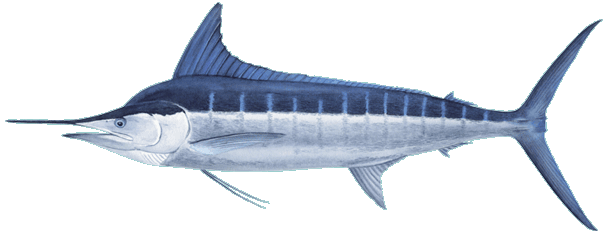
STRIPED MARLIN (NAIRAGI)
Hawaii Market Name: Nairagi
Scientific Name: Tetrapturus audax
Hawaiian Name: A`u
Japanese Name: Makijiki
Nairagi is commonly known as striped marlin, or a`u, the Hawaiian name applied to all marlin species. It has the slenderest bill and the most visible “stripes” of all billfish and a high, pointed dorsal fin and more compressed sides.
The flesh color of striped marlin varies from fish to fish and varies from light pink to orange-red. Fish with orange-red flesh are particularly desired for the sashimi market. Nairagi with pink to light-colored flesh are bought for up-scale restaurants. It is considered the finest eating of all marlin species because of its tender flesh.
Nairagi caught around the Hawaiian Islands usually between 40 and 100 pounds in round weight and are rarely over 130 pounds.
FISHING METHODS
All Hawaii striped marlin are line-caught. Most of the catch in Hawaii is by longline boats fishing in the open ocean. However, some are caught near shore by slow trolling with live bait or lures during certain times of the year.
SEASONALITY
The heaviest landings of Nairagi are November through June.
PREPARATION NOTES
Texture: Firm
Flavor: Mild
Suggested Preparations: Raw (sashimi, sushi, poke, ceviche), Broiled, Grilled, Sautéed, Smoked, Tempura
Nairagi is frequently used in raw fish. Ideal for grilling. It can also be used in cold seafood dishes and salads. Also popular for gourmet smoked fish products.
HEALTH & NUTRITION
Hawaii Striped Marlin is an excellent source of healthy, extra lean protein. It is also low in saturated fat and low in sodium. It is rich in niacin, vitamin B6, vitamin B12, phosphorus and selenium. Hawaii Striped Marlin also provides about 825 mg of omega-3’s (DHA and EPA) per 4 ounce serving of fresh fish. Click here for nutritional labels and claims.
Click here to download a two-page description of this species.

